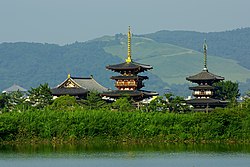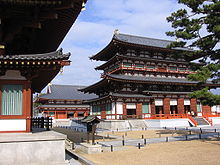Yakushi-ji is one of the most famous imperial and ancient Buddhist temples in Japan, located in Nara. The temple is the headquarters of the Hossō school of Japanese Buddhism. Yakushi-ji is one of the sites that are collectively inscribed as a UNESCO World Heritage Site, under the name of "Historic Monuments of Ancient Nara."
The main object of veneration, Yakushi Nyorai, also named "The Medicine Buddha", was one of first Buddhist Deities to arrive in Japan from China in 680, and gives the temple its name.
History
 The original Yakushi-ji was built in Fujiwara-kyō, Japan's capital in the Asuka period, commissioned by Emperor Temmu in 680 to pray for recovery from illness for his consort, who succeeded him as Empress Jitō. This act of building temples in devotion to Buddhist figures was a common practice among Japanese nobility when Buddhism was first imported from China and Korea. Emperor Temmu had died by the time Empress Jitō completed the complex around 698; and it was disassembled and moved to Nara eight years after the Imperial Court settled in what was then the new capital.
The original Yakushi-ji was built in Fujiwara-kyō, Japan's capital in the Asuka period, commissioned by Emperor Temmu in 680 to pray for recovery from illness for his consort, who succeeded him as Empress Jitō. This act of building temples in devotion to Buddhist figures was a common practice among Japanese nobility when Buddhism was first imported from China and Korea. Emperor Temmu had died by the time Empress Jitō completed the complex around 698; and it was disassembled and moved to Nara eight years after the Imperial Court settled in what was then the new capital. It has been long believed that the temple was moved to its present location in 718, following the move of the capital to Heijō-kyō known today as Nara. However, excavations of the Fujiwara-kyō Yakushi-ji site in the 1990s suggest that there may have been two Yakushi-jis at one time. The Fujiwara-kyō Yakushi-ji is also referred to as Moto Yakushi-ji (moto, original).
It has been long believed that the temple was moved to its present location in 718, following the move of the capital to Heijō-kyō known today as Nara. However, excavations of the Fujiwara-kyō Yakushi-ji site in the 1990s suggest that there may have been two Yakushi-jis at one time. The Fujiwara-kyō Yakushi-ji is also referred to as Moto Yakushi-ji (moto, original).Fires destroyed most buildings of the complex in 973, and the main hall in 1528. Much hard work has been put in to restoration: the main hall was rebuilt in the 1970s, and the entire temple is now completely restored.
Partial remains of the famous Chinese Buddhist Monk named Xuanzang are enshrined at Yakushi-ji, taken from Nanjing, China by the Japanese Imperial Army during WWII.
Yakushi-ji's layout is symmetrical, with two main halls and two three-story pagodas. The unique layout is also sometimes referred to as “yakushiji-style”.
Source: http://en.wikipedia.org/wiki/Yakushi-ji
Images: http://commons.wikimedia.org/wiki/Category:Yakushiji















0 comments:
Post a Comment